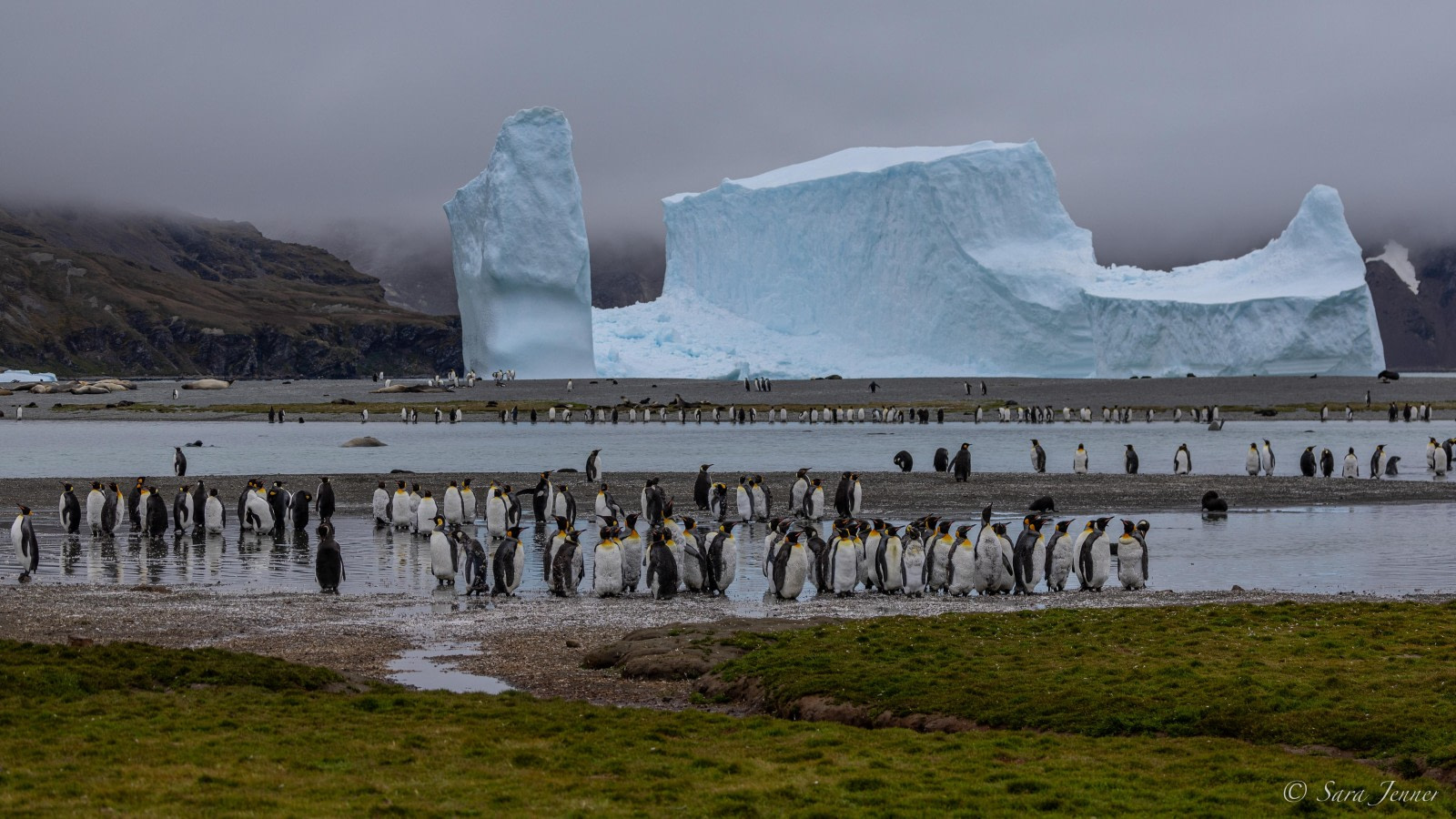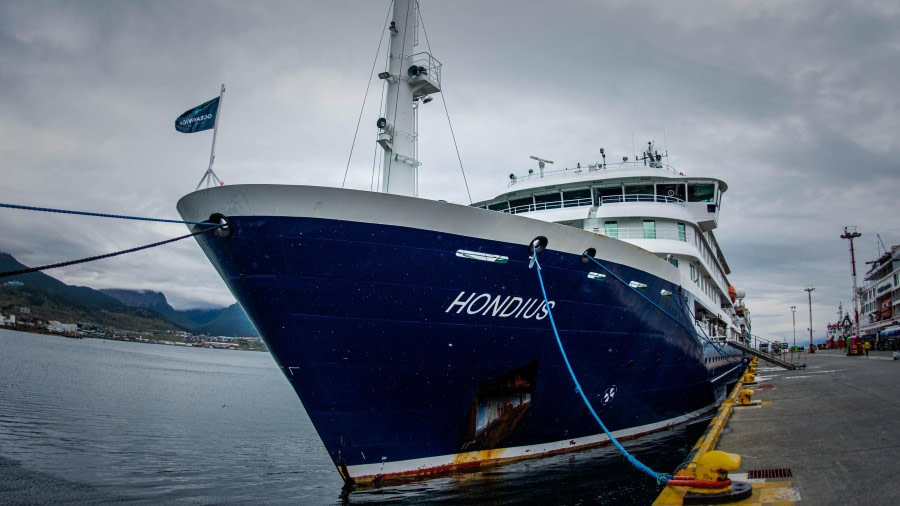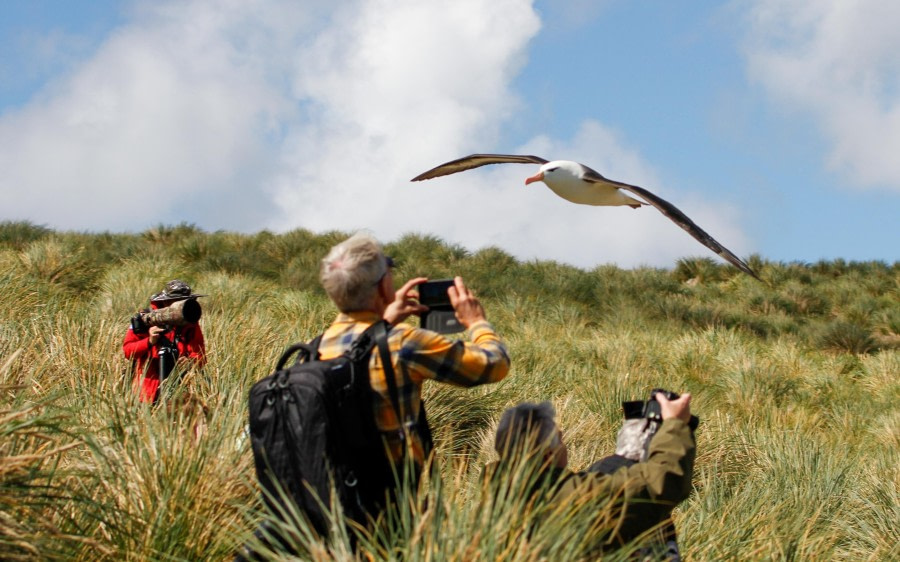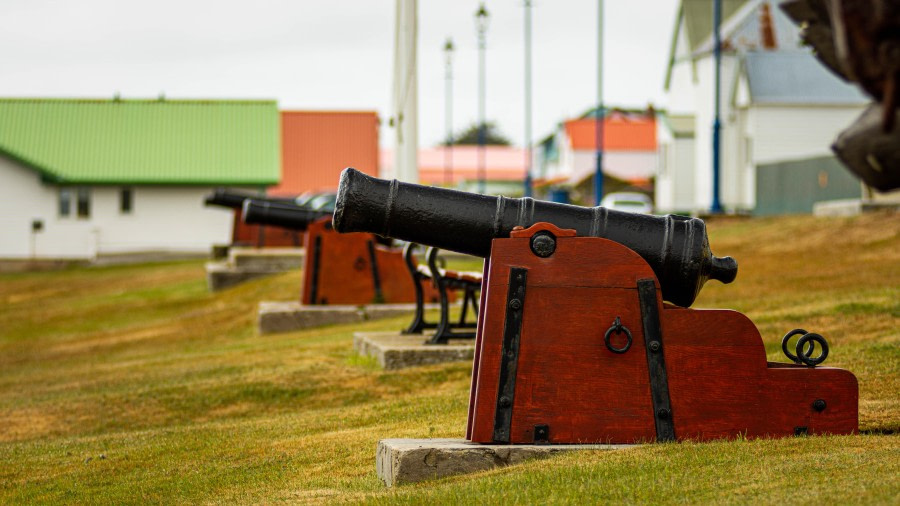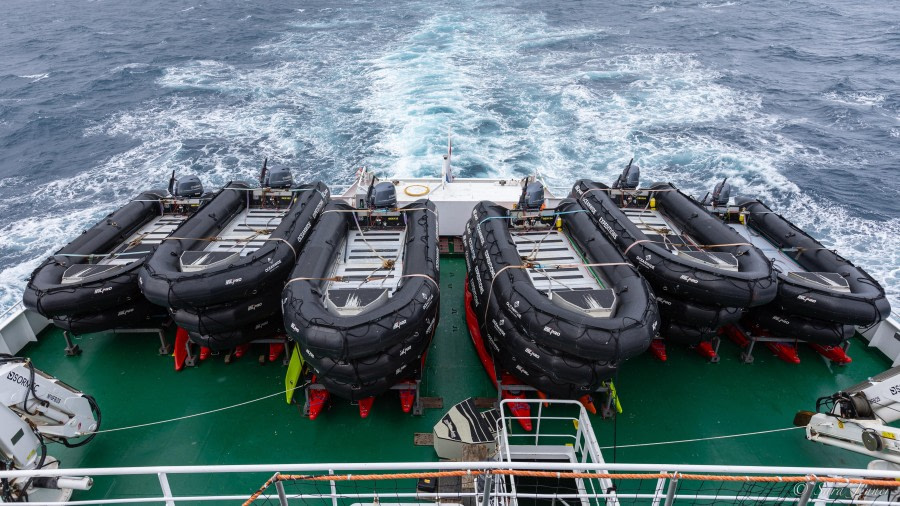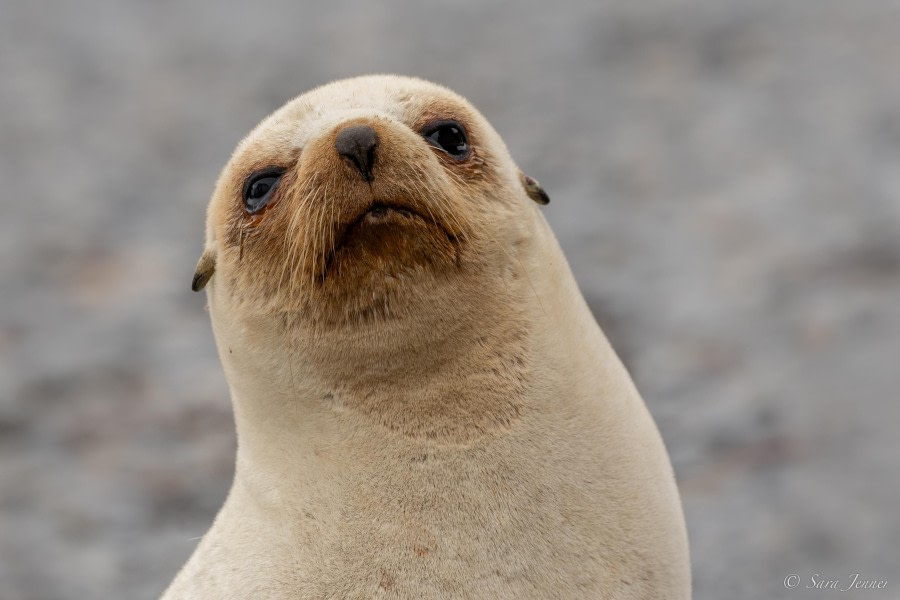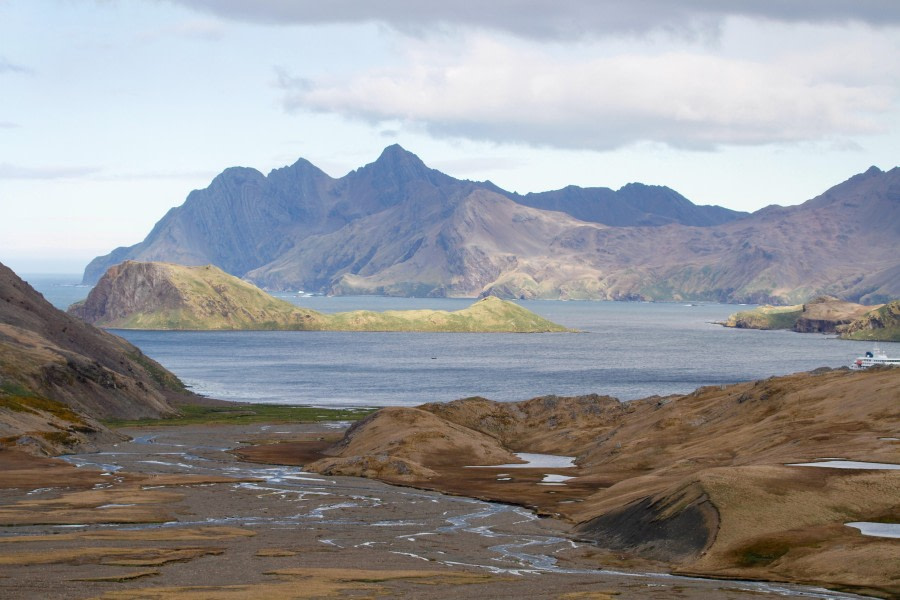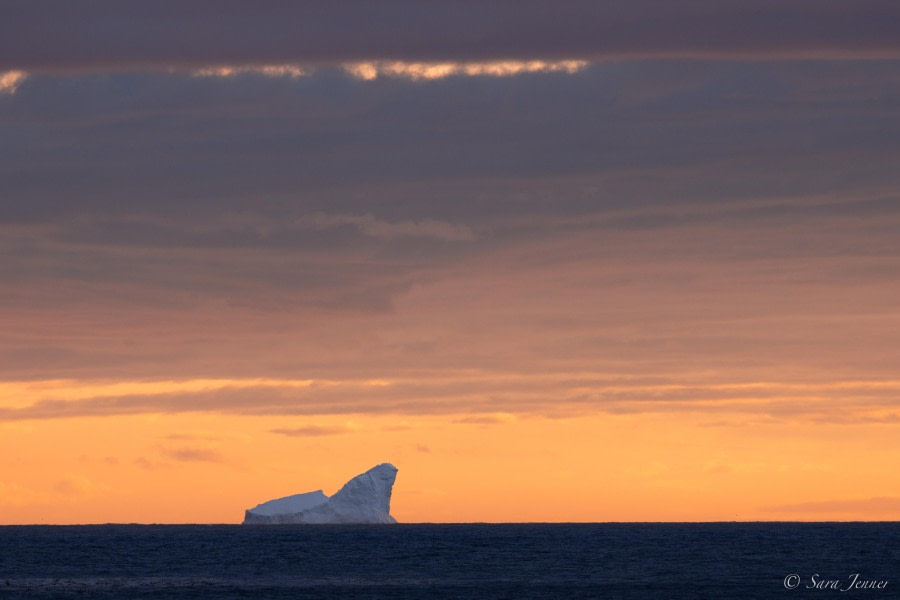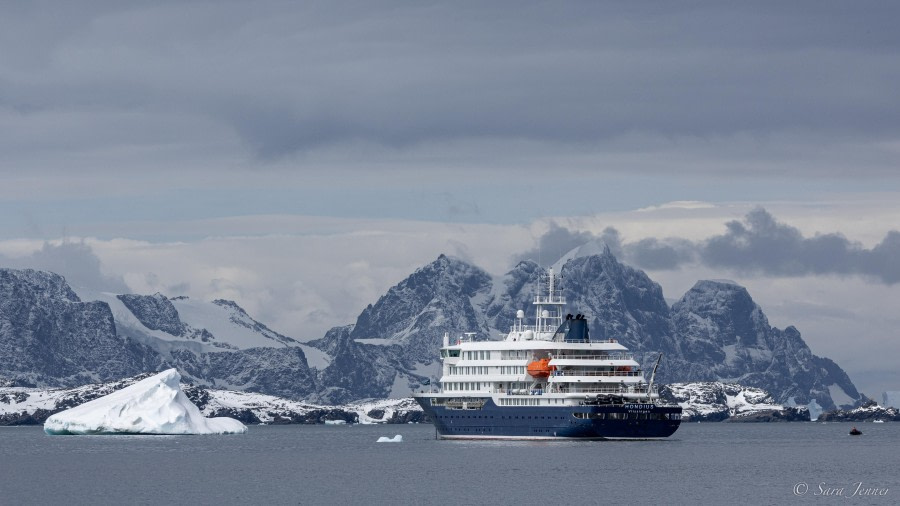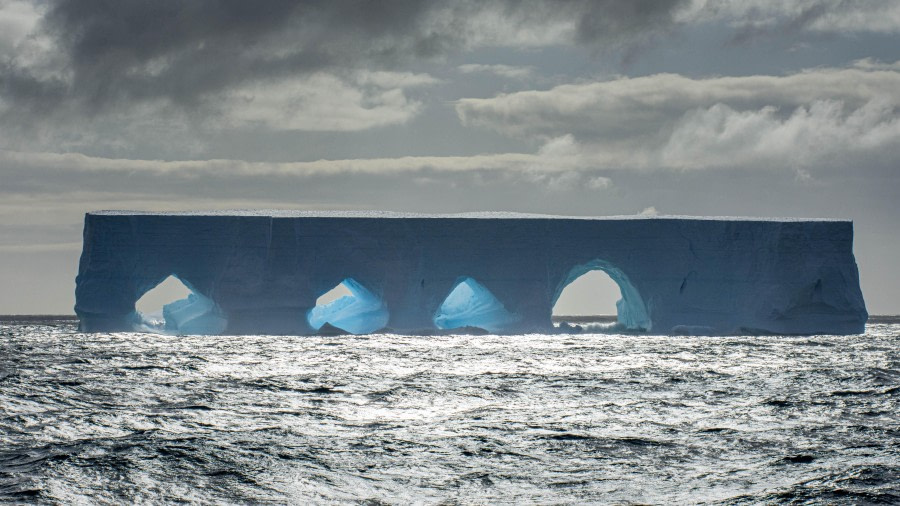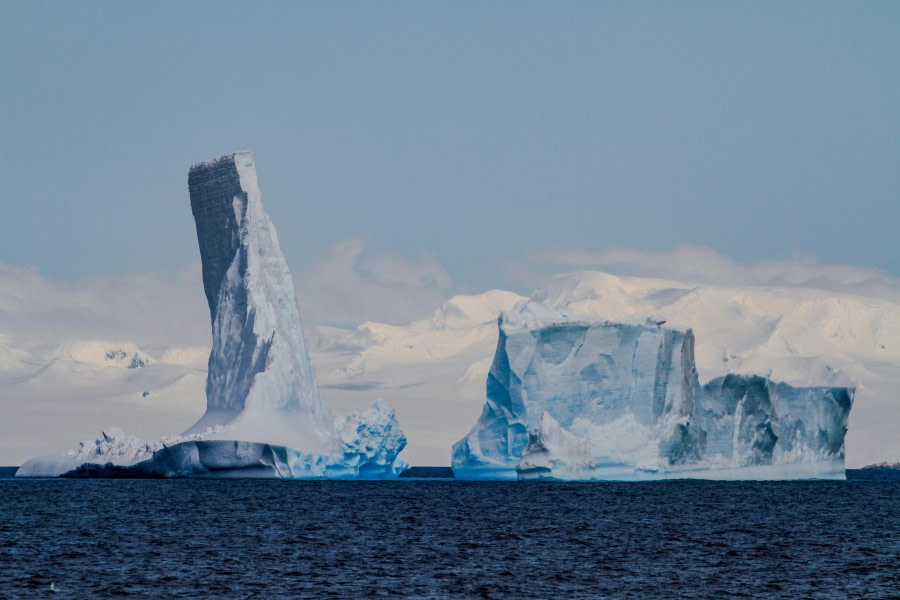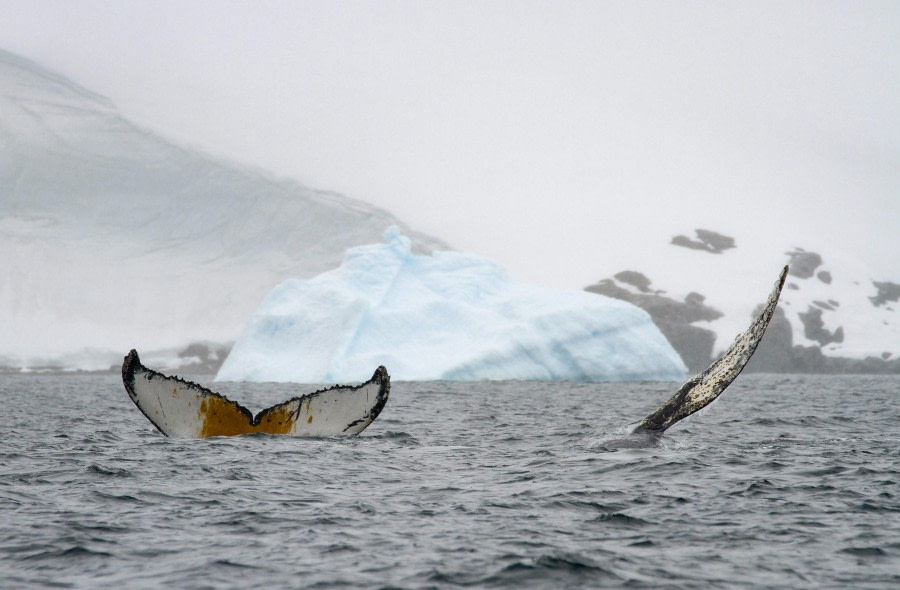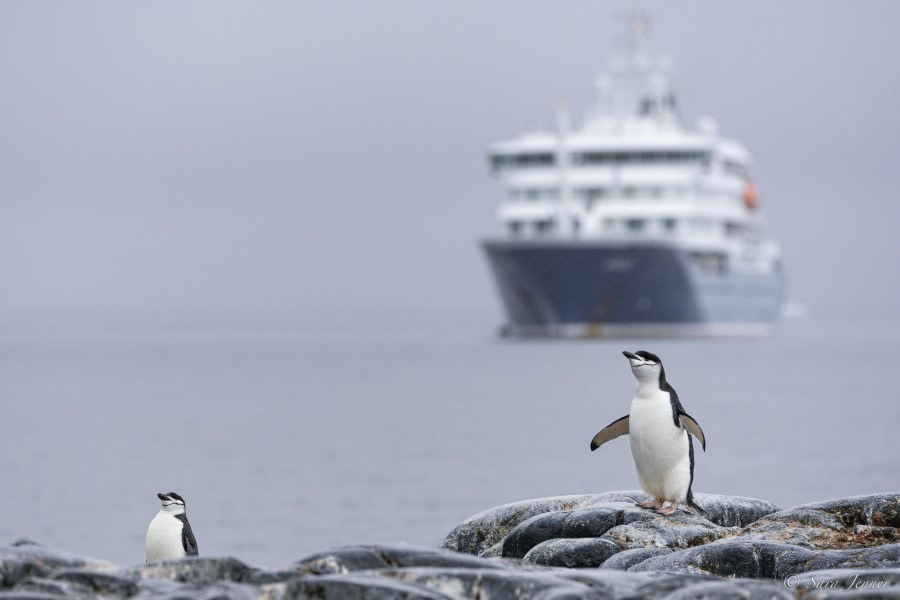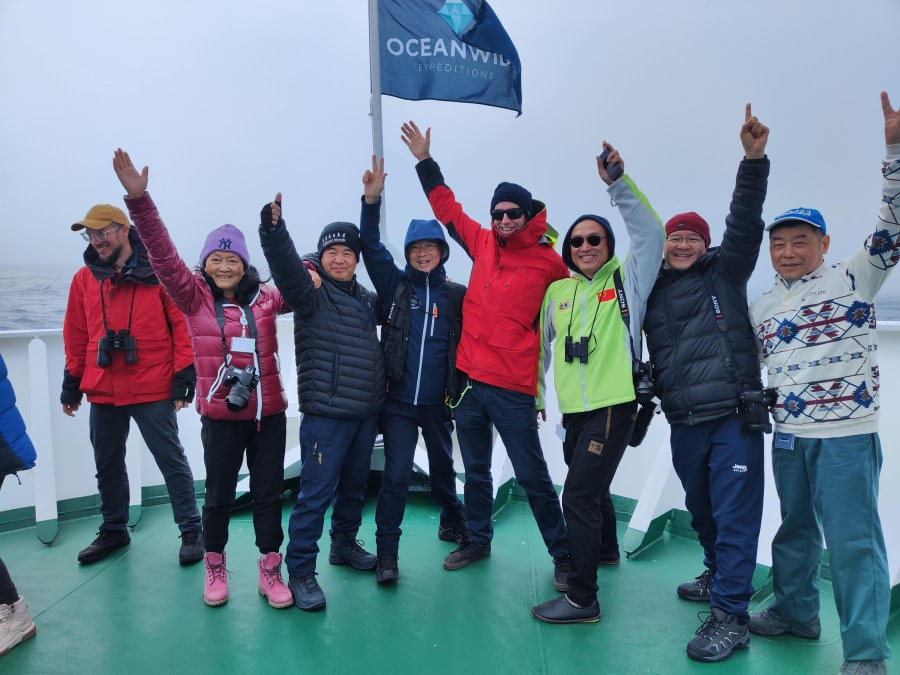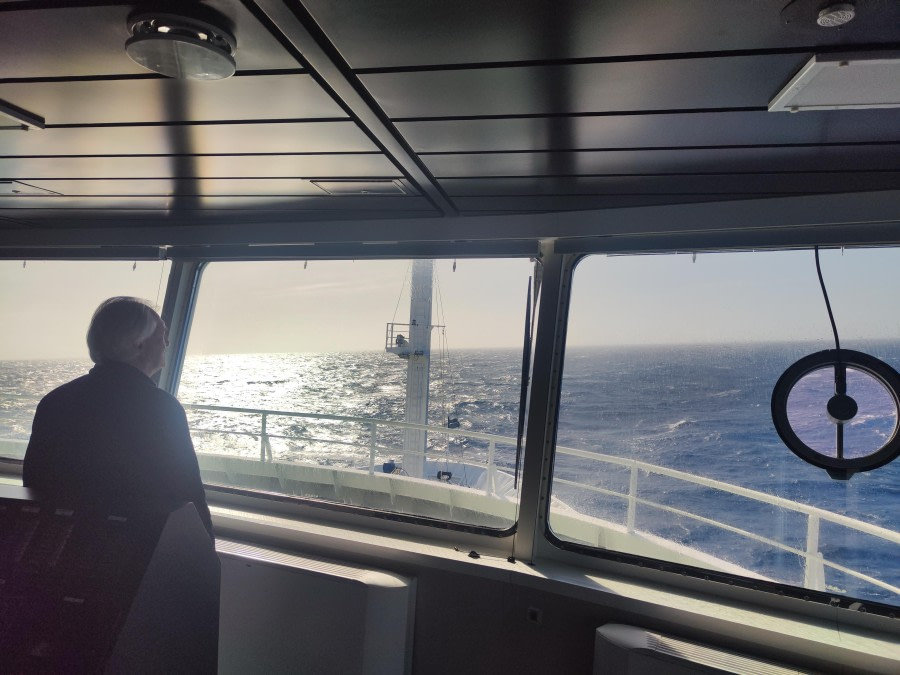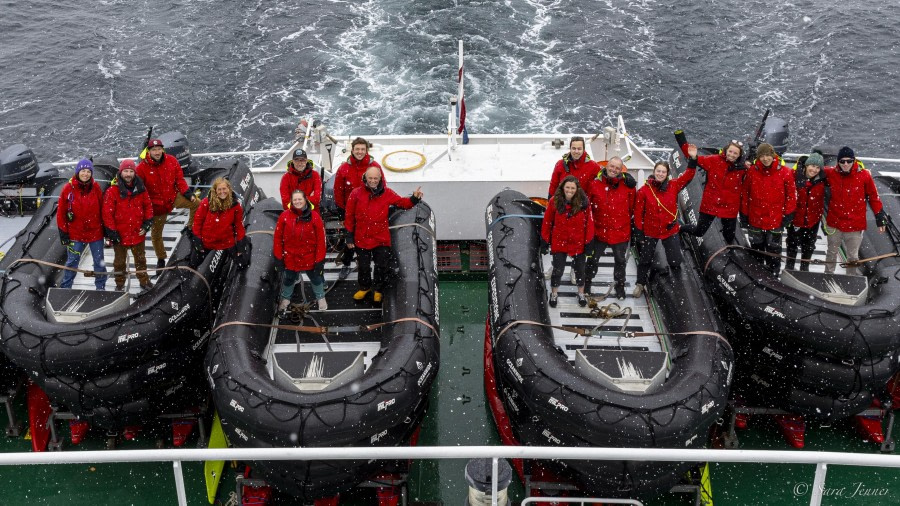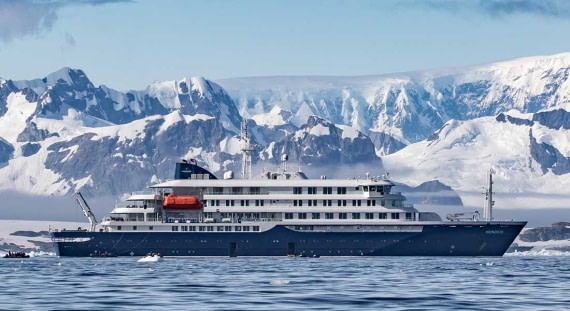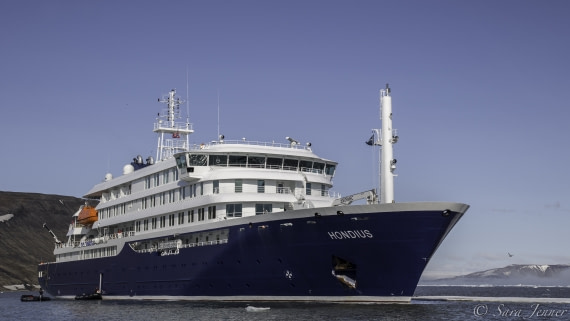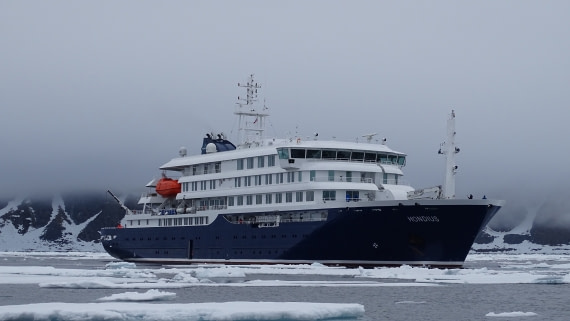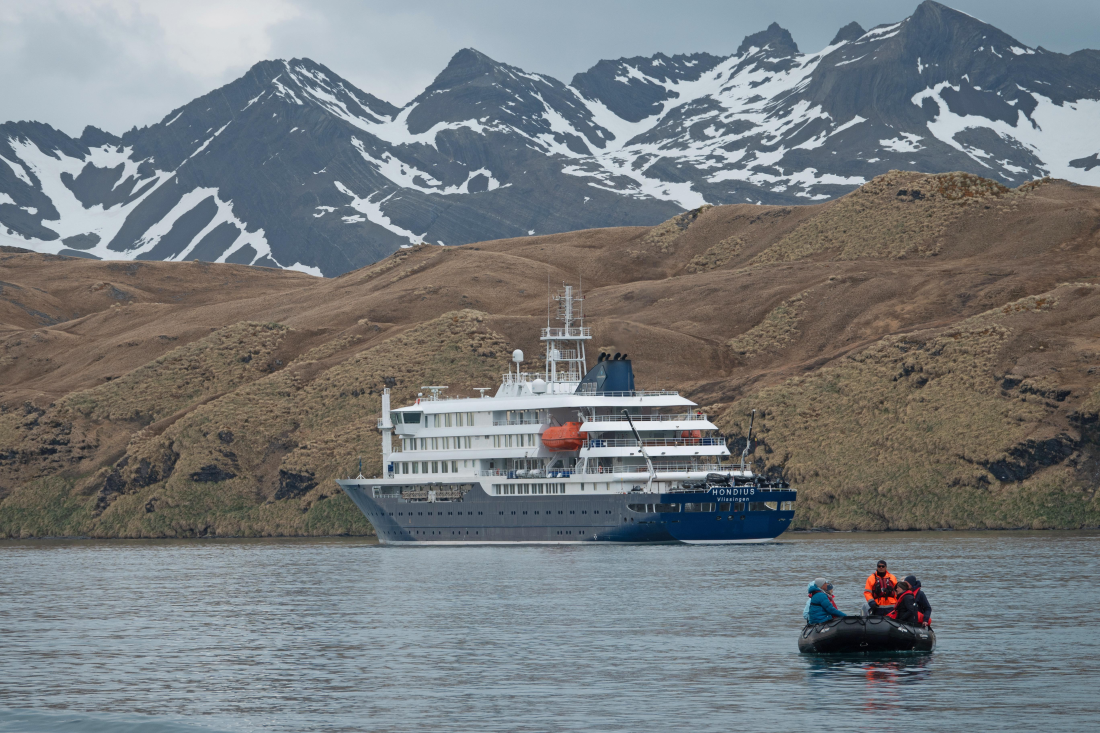| Datum: |
12.01.2024 |
| Positie: |
54°05.5’ S / 036°36.2’ W |
| Wind: |
W 3 |
| Weer: |
Clear |
| Luchttemperatuur: |
+12 |
South Georgia chose to exchange wrath for mercy. As if deciding that the rain wall it had erected against us the morning before was enough, it resolved to treat us to genuinely fine weather. The sun played with glints on the smooth surface of the sea, the tussock grass covering the shores and numerous tiny islets around us, still damp from the rain, vibrantly green. South Georgian pipits darted to and fro with exuberant chirping, overwhelmed with joy. Fifteen minutes before breakfast, the familiar call of "Good morning, good morning, good morning" echoed from the speakers embedded in the ceiling. Approaching the window and drawing the curtains was enough to confirm that the morning was indeed splendid!
Hondius dropped anchor in Leith Harbour, opposite the eponymous old abandoned whaling station. A century ago, it was the largest whaling station in South Georgia. Even now, long after the station was abandoned, fallen into complete disrepair, and gradually crumbling into pieces, letting nature reclaim its territories, it still looks quite impressive. Many of us had already dressed before breakfast and stepped onto the open decks to capture in photographs the panorama of Leith station with its rusty pipes, chimneys huge whale oil reservoirs, and tilting barracks and shacks, where brave whalers once sought refuge. Leith Station doesn't have much time left standing in its place. Antarctic winds and incessant rains, like scavengers, tear its carcass apart, gradually turning this once oasis and outpost of civilization in the distant Antarctic latitudes into nothingness.
A landing was scheduled for the morning. The night before, we had agreed to split into two groups: those who wanted to stretch their legs and embark on a three-hour hike through the valley, and those who simply wanted to leisurely stroll along the shore and observe the local wildlife. The long hikers were to arrive at the zodiac boarding area first, and it must be said that there were quite a few of them. Our guides, skilfully navigating through kelp thickets, first ferried them all ashore on Zodiacs, and then it was the turn of those who aimed not for movement but contemplation.
The landing site was quite a distance from the whaling station, and it was not without reason. During the construction of the facilities, a material called asbestos was actively used. Only many years later did it become apparent that asbestos is toxic. Therefore, even though all the asbestos had long been carefully collected and removed, a 200-meter exclusion zone is still in place around the station. Moreover, a gust of wind could at any moment dislodge some loosened sheet of iron, sending it crashing down on the heads of those unfortunate enough to be nearby. .
The shore teemed with life! Everywhere, there were vast numbers of Fur seal pups, joyfully and still somewhat clumsily moving about on their flippers. Despite being born just a month or so ago, the pups already possessed a typical stern demeanour — they frequently growled at us and bared their tiny teeth, as if saying, "Don't come closer, stranger, or it'll be worse for you!" Mothers were also scattered everywhere, whether on the beach, hillside, or tussock grass, emitting long, howl-like cries, trying to attract their offspring: "Come here faster! It's time for lunch! My mammary glands are full of nourishment!" Once the pups found their mothers, they immediately began to suckle, squinting with pleasure.
Near a large pool with flowing water, an extension of a small stream, just a few dozen meters from the shoreline, King penguins stood still and concentrated. They stood there for a reason — it was moulting time. During this period, the unfortunate birds must simply stand in place and wait for their old feathers to fall out and new ones to grow. Until this happens, penguins cannot come into contact with seawater and, consequently, cannot hunt and procure food for themselves. We kept our distance from them, trying not to disturb.
A bit further, among the tussock grass bushes, lay young elephant seals. Some of them peacefully slept, while others stared at us with surprise, lifting their heads and peering at us with their enormous, entirely black eyes. Their parents had long since headed to the sea to feed, catching squid and fish, leaving their offspring on the shore. Some elephant seal pups, like the penguins, were moulting, shedding their old fur and waiting for the new one to grow. They looked quite amusing in the process.
The sun shone brightly. Despite our habit of dressing warmly, we had to shed a few unnecessary layers of clothing and tuck them into our backpacks. In conditions where there was a strict prohibition against placing or folding anything on the ground, doing so was quite challenging. We had to rely on each other and ask for help to hold either a backpack, a jacket, or a camera.
After overcoming the first two hundred meters from the shore into the interior of the island, we found ourselves on a vast meadow covered with low dark-green grass. We had to step over small streams that playfully descended from the mountain slopes. Somewhere in the middle of this vast meadow, a pair of skuas had constructed a nest. Their only chick was already large enough to take walks around the nest, but the parents still vigilantly guarded it, maintaining a watch and not allowing anyone to approach. Just in case, the watch was reinforced with Simon, our ornithologist guide.
The soil in the meadow was peat, and it bounced beneath our steps, making our stroll slightly energy-consuming. However, at the end of the path, a decent observation point awaited us, offering a view of the abandoned whaling station of Leith. Countless enormous tanks for storing blubber. Giant rusty cylinders with cone-shaped roofs resembling Vietnamese hats. It's terrifying to even think about how many unfortunate animals had to perish to fill these gruesome storages. But such is the price that humanity had to pay for its scientific and technological progress. Now, awakened to the reality, we rushed to protect whales and guard them in every possible way. It remains only to hope that this awareness came to us when it was not too late. The recovery of the whale population is a slow process, and stations like Leith, along with other whaling stations in South Georgia, may crumble into dust before the whale numbers in the Southern Ocean reach their former levels.
A bit aside from the whaling station, crosses and obelisks marked a small cemetery. Here rested those who once, driven by necessity, came here, leaving their homes and beloved families, hoping to earn money and somehow improve their financial situation. They arrived — and, miscalculating their strength, fell victim to the harsh nature of these places, dangerous work, diseases, and unfortunate accidents. Wives never saw the return of their husbands, and children never saw their fathers. A terse telegram written in bureaucratic language, along with a small financial compensation from the company's management, that's all. Sleep, friends, perhaps those who carry the memory of you in their hearts are still alive.
Not far from the cemetery, a group of moulting King penguins stood motionless, as if commemorating the departed.
In one way or another, around noon, it was time to return to the ship. The long hikers returned from their route. The Zodiacs, buzzing softly, ferried all of us back to the Hondius within a few minutes, and we happily headed to the restaurant for lunch.
While we were dining, Hondius raised anchor and set a course for the neighbouring harbour, where another abandoned whaling station called Husvik stood on the shore. We reached it fairly quickly. There were no planned landings on the shore. Instead, the expedition team organized a Zodiac cruise for us. After dressing up, we boarded the Zodiacs in groups of ten and, with our cameras ready, set out to explore this corner of South Georgia.
Husvik Bay was shallow, overgrown with a kelp forest. Our guides, maneuvering the Zodiacs, had to lift the engines and clear the propellers from the tangled kelp quite often. Nevertheless, life was bustling in the coastal zone. The same Fur seal pups under the guardianship of adult females, young elephant seals, South Georgian Pin-tailed ducks, pipits, Kelp Gulls, and Giant petrels — no one escaped the lenses of our cameras.
The whaling station itself was much smaller in size than Leith, but here too, we could see old rusty tanks for blubber, barracks for employees, and a grass-covered semi-ruined jetty. One of the buildings, standing apart from the station, looked entirely new—it was the so-called Governor's Cottage, restored by the Government of South Georgia and now used for its purposes.
Slightly aside from the settlement on the shore, a small ship repair yard was situated, where once repairs and technical maintenance of the so-called catchers took place — small, high-speed vessels that harpooned whales. One of the boats remained standing on the slipway. Gloomy and sad, it looked in the ambiance of the semi-ruined and abandoned shipyard. The enormous propeller had four blades. The wooden cabin on the deck had long decayed and tilted; nonetheless, the boat's sides, although rusty, still looked quite fresh. It seemed as if the boat stood in bewilderment and anticipation. Where had everyone gone? And what about her? Perhaps, it thought that people would return to the shipyard soon, walk along its sides with sandpaper, cover them with fresh paint, fill the fuel tank, lubricate its joints and connections, and it would again rush into the distance, cutting through the giant waves of the Southern Ocean with enthusiasm… No. No one will come. Never. It will stand alone on the slipway until the wind and atmospheric precipitation finally destroy it completely.
An hour after the start of the Zodiac cruise, unfortunately, the weather began to reveal its unpleasant and capricious nature. The wind picked up, and angry, aggressive waves ran across the harbour’s surface, striking the Zodiacs on the sides, attempting to spray us with salty seawater. By that time, we had already seen everything that Husvik's whaling station harbour had to offer, so our guides directed the boats towards the ship, and we safely returned to the Hondius.
The day was not yet over. Before bidding a final farewell to South Georgia, we set a goal to visit St. Andrew's Bay — arguably the most legendary place on the entire island — known for being home to an enormous colony of nearly 600,000 King Penguins. Besides them, it hosts elephant seals, fur seals, Giant Petrels, and many others. Unfortunately, this year misfortune reached South Georgia — an outbreak of avian influenza, affecting not only birds but also marine mammals. The Government of South Georgia took several measures to prevent the spread of the epidemic to other parts of the island, including a ban on landings and Zodiac cruises along the shore of St. Andrew's Bay. After several hours of navigation and manoeuvring among enormous icebergs brought by the current from Antarctica, we could only approach the shore at a distance of two nautical miles. Nevertheless, it was enough to observe through binoculars the gigantic crowd of penguins.
It was raining. It seemed as if nature was mourning the tragically and untimely lost beings. Twilight prevailed as the rays of the low pre-sunset sun struggled to penetrate through the thick veil of clouds. On this slightly somber note, our stay on this enchanting island came to an end. The captain turned the ship around, and as Hondius, heading for Antarctica, roared its engines, it began to gain speed. The coast of South Georgia remained astern, gradually receding and dissolving in the haze of mist and raindrops.
Farewell, South Georgia, who knows, perhaps we will meet again. Animals, recover soon!
